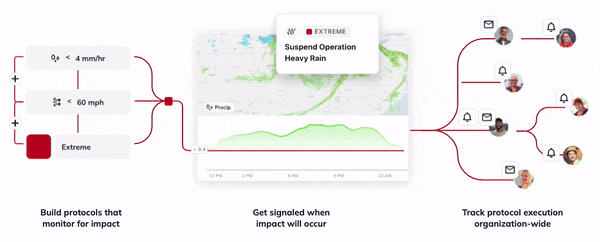TL;DR:
- Wind alerts dominated last year, increasing asset damage risk.
- Logistics industry faced 10x more alerts than others, adapting with flexible scheduling and route optimization.
- 70% of alerts required urgent action, emphasizing the need for rapid decision-making processes.
- Heat emerged as a major operational challenge, prompting businesses to implement cooling systems and adjust work schedules.
- Businesses can enhance resilience by fortifying against wind, streamlining supply chains, empowering quick responses, and mastering heat management.
As we approach another record-breaking July 4th travel season, with an expected 70.9 million Americans journeying 50 miles or more from home, businesses face unique challenges.
Last year’s data from our Resilience Platform offers crucial insights for enterprise leaders preparing for this year’s holiday rush.
Wind Alerts Dominated, Increasing Asset Damage Risk

Tomorrow.io’s Resilience Platform shows you the probable impact of wind on your set locations to improve decision making.
Wind-related alerts dominated the landscape last year, accounting for 42% of all weather alerts.
This prevalence highlighted the increased risk of structural damage and operational interruptions faced by businesses. Many companies responded by implementing rapid response protocols specifically for wind-related incidents. These protocols included measures such as securing loose equipment, reinforcing temporary structures, and establishing clear communication channels for quick decision-making during high-wind events.
Logistics Industry Faced 10x More Alerts Than Others
The logistics industry found itself at the epicenter of weather-related challenges, generating 10 times more alerts than other industries.
This surge in alerts reflected the intense pressure on supply chains, which struggled with weather-induced delays and route disruptions. Successful firms adapted by adopting flexible scheduling practices and implementing real-time route optimization technologies. These strategies allowed logistics companies to dynamically adjust their operations in response to changing weather conditions, minimizing delays and maintaining service levels despite the challenging environment.
70% of Alerts Required Urgent Action
Last year’s data revealed that 7 out of 10 weather alerts required urgent action, underscoring the need for rapid and effective decision-making processes.

Tomorrow.io’s Resilience Platform tie your protocols to the weather to send you decision-making alerts
Organizations faced the challenge of making critical decisions quickly and frequently throughout the holiday period. Businesses that thrived in this high-pressure environment had clear escalation procedures in place and empowered local managers to make time-sensitive decisions. This approach allowed for faster responses to emerging weather threats and helped minimize the impact on operations and customer service.
Heat Emerged as a Major Operational Challenge
Temperature-related alerts emerged as the third most common type, highlighting heat as a rising concern for operations. Companies grappled with dual challenges: protecting temperature-sensitive equipment from overheating and ensuring worker safety in hot conditions. Proactive businesses responded by implementing advanced cooling systems for critical infrastructure and adjusting work schedules to avoid the hottest parts of the day. Some organizations also introduced additional break periods and hydration stations to protect worker health and maintain productivity in challenging conditions.
Preparing for This Year’s July 4th Weekend
Building on these insights, here are steps businesses can take to enhance their resilience:
- Fortify Against the Wind: Prioritize structural assessments and reinforce vulnerable assets. Develop and drill wind-specific emergency response plans.
- Streamline Supply Chains: Enhance communication systems and build in operational flexibility. Implement real-time tracking and rerouting capabilities to adapt to weather-related disruptions quickly.
- Empower Quick Responses: Implement a tiered alert system and train staff on rapid decision-making. Ensure clear lines of authority for weather-related operational changes.
- Master Heat Management: Upgrade cooling infrastructure for both equipment and personnel. Revise worker safety protocols to account for extreme heat conditions.
As we face another potentially record-breaking travel season, the lessons from last year underscore the importance of proactive resilience planning. By understanding and preparing for these weather-related challenges, businesses can protect their assets, maintain operational continuity, and ensure the safety of their workforce.
Don’t let weather disrupt your operations this holiday season.
Discover how our Resilience Platform can safeguard your business with real-time insights and actionable intelligence.
Schedule a demo today to learn more about strengthening your organization’s weather resilience.















